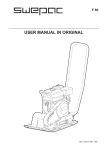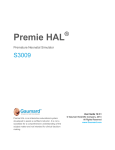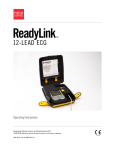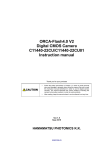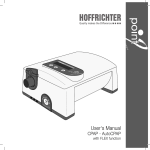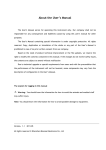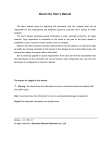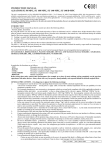Download User Manuals - HeRO by MPSC
Transcript
HeRO solo ® & HeRO duet ® Version 3.1 System Manual COPYRIGHT © 2015 BY MEDICAL PREDICTIVE SCIENCE CORP. ALL RIGHTS RESERVED. UNAUTHORIZED REPRODUCTION IS STRICTLY PROHIBITED. Do not alter or translate these materials or any part thereof in any form by any means, except by prior written authorization from Medical Predictive Science Corporation. Medical Predictive Science Corporation, Inc. makes no warranties, express or implied, regarding these materials, including but not limited to any warranties of merchantability or fitness for a particular purpose. Medical Predictive Science Corporation, Inc. makes these materials available solely on an "as -is" basis. Medical Predictive Science Corporation, Inc. accepts no responsibility for altered or edited versions of these materials. Medical Predictive Science Corporation, Inc. reserves the right to revise and improve its products as it sees fit. This publication describes the state of the product at the time of this publication only, and may not represent or describe the product at all times in the future. Electronic Access to HeRO System Manuals HeRO User Manuals are available in electronic form. To access the electronic copies of the documents, you will need a device connected to the Internet and have installed Adobe Acrobat Reader. There is a link to obtain Adobe Acrobat Reader on the HeRO website. You can access the HeRO website by clicking “Help” from a HeRO screen, or by typing http://www.heroscore.com/Technical_Support.htm from a web browser. If you need help accessing the electronic copies of the documents or to request a printed copy at any time contact the appropriate representative on page 2 of this manual. Single printed copies are available at no additional cost and will be delivered within seven days of receiving the request. Document Number: MPSC-INS-1621 (R1.08) HeRO, The Power to Predict, and the MPSC logo are trademarks or registered trademarks of Medical Predictive Science Corporation, Inc. Microsoft and Windows are registered trademarks of Microsoft Corporation. CONTACT INFORMATION Contact Information Distributor List Austria Connect Medizintechnik GmbH Gspanngasse 4 A-2130 Mistelbach, Austria Ph: +43 2572 32400 FAX: +43 2572 20404 Email: [email protected] Web: www.connect-medizintechnik.at Kuwait Al-Essa Medical & Scientific Equipment Co. W.L.L. #118 Sector C, Street 33, Shuwaikh Ind. Area, Kuwait PH: +965 2 483 4510 FAX: +965 2 484 0629 Email: [email protected] Web: www.alessakuwait.com The Netherlands Medisize bv Edisonstraat 1 2181 AB Hillegom PH: +31 (0)252-576 888 Email: [email protected] Web: www.medisize.com Saudi Arabia Gulf Neocare PO Box 365899 Riyadh, 11391 Saudi Arabia PH: +996 1 464 8545 Web: www.gulfneocare.com United Kingdom SLE Ltd Twin Bridges Business Park 232 Selsdon Road South Croydon CR2 6PL, UK Ph: +44 (0) 208 6811414 ext 251 Fax: +44 (0) 208 6498570 Web: www.sle.co.uk Egypt Egyptian Engineering & Industrial Office 18 Hoda Shaarawi St. Cairo 11511 Egypt PH: +20 2 23951195 Web: www.eeiomedical.com M Manufacturer and for all P EC Authorized other Countries Representative Medical Predictive Science Corporation 2246 Ivy Rd, Suite 17 Charlottesville VA 22903 USA T: +1 434-220-0714 Fax: + 1 240-220-6098 E-mail: [email protected] www.heroscore.com Emergo European Authorized Representation Molenstraat 15 2513 BH, The Hague The Netherlands Telephone: +31.70.345.8570 Fax: +31.70.346.7299 -2- TABLE OF CONTENTS Contact Information .......................................................................................................... 2 Distributor List ............................................................................................................... 2 M Manufacturer and for all other Countries ............................................................... 2 P EC Authorized Representative.............................................................................. 2 Introduction ........................................................................................................................ 5 Indications for Use ........................................................................................................ 6 Contraindications .......................................................................................................... 6 Precautions .................................................................................................................... 6 Environmental Requirements ....................................................................................... 8 Using this Manual .......................................................................................................... 8 Overview ............................................................................................................................. 9 Data Acquisition............................................................................................................. 9 Using HeRO solo and HeRO duet ............................................................................. 11 Setting Up .................................................................................................................... 11 Powering down ............................................................................................................ 12 Viewing the HeRO Score ............................................................................................ 13 duet View (only available on HeRO duet ) ............................................................ 14 Patient View (HeRO solo and HeRO duet )........................................................... 15 Activating HeRO solo and HeRO duet .................................................................. 17 Pausing an Alarm .................................................................................................... 17 Continuous HeRO Monitoring ................................................................................ 17 Status and Error Messages .................................................................................... 18 Alarms ........................................................................................................................... 19 Interpreting Results ......................................................................................................... 20 Troubleshooting ............................................................................................................... 21 HeRO Technical Information and Installation Guidelines ........................................... 23 Site Location................................................................................................................ 23 Cabling.......................................................................................................................... 23 Cleaning........................................................................................................................ 24 Description of Markings.............................................................................................. 25 Modifications................................................................................................................ 26 Environmental Impact ................................................................................................. 26 Electrical Isolation ....................................................................................................... 26 Electromagnetic Compatibility ................................................................................... 26 Appendix A: Theory of Operation ................................................................................. 30 Algorithms for Calculating RRI Parameters.............................................................. 30 -3- TABLE OF CONTENTS QRS Detection (where applicable) ....................................................................... 30 Data Packaging........................................................................................................ 31 Data Conditioning Prior to Calculation of HRV.................................................... 31 Mathematical Analysis ............................................................................................ 31 Mathematical Modeling .............................................................................................. 33 Logistic Regression................................................................................................. 33 Fold Increase Score................................................................................................ 33 HeRO Score............................................................................................................. 34 References: .................................................................................................................. 34 Appendix B: Glossary..................................................................................................... 35 Appendix C: Use of HeRO Score in the Assessment of Infection ............................. 38 -4- INTRODUCTION Introduction HeRO provides an automated, noninvasive method to detect transient decelerations and reduced baseline heart rate variability. HeRO continuously acquires, records, measures and analyzes variations in RR Intervals, and provides ongoing display of this information. HeRO is used to: Continuously acquire heart rate data from an existing physiological monitor Identify and determine the length of time between individual heart beats (the R-R Interval) Calculate a set of measures from these R-R Intervals to characterize the heart rate pattern Compute an “index” based on the degree of decelerations and reduced baseline variability in these patterns, Calculate the HeRO Score, which expresses the index as a fold-increase risk of sepsis relative to the overall NICU population, and Provide this information to clinicians in a timely and intuitive fashion. HeRO solo and HeRO duet are self-contained implementations of HeRO and are built upon the same technology platform. The monitors share a hardware platform, with the difference being in the number of patients monitored. Each processes ECG data from one (solo) or two (duet) patient monitors and shows HeRO Scores for the monitored bed(s). In this document, HeRO solo or HeRO duet refer to the HeRO Display and, as applicable, the HeRO Data Acquisition Device (AD2). -5- INTRODUCTION Indications for Use HeRO is intended to acquire, store, analyze, and report on ECG data collected from infants. HeRO is intended to be used by trained operators under the direct supervision of a licensed health care practitioner in a hospital neonatal or pediatric ICU environment. HeRO is intended to be used for the analysis of the variability in RR Intervals (heart rate) and to report measurements of the variability of heart rate data (HRV). The HRV measurements reported by HeRO are specialized in nature, and intended to identify periods of transient decelerations and/or reduced baseline variability in the heart rate. HeRO is intended to provide specialized HRV measurements and may detect arrhythmias, that when combined with other risk factors, can be used as an aid in assessing the risk of sepsis in infants. The use of HeRO monitoring improves survival in very low birth weight neonates. HeRO solo and HeRO duet acquire data from a user-supplied ECG monitor. Initial training and support are to be performed by Medical Predictive Science Corporation employees or contractors who have been certified by Medical Predictive Science Corporation as qualified to perform such duties. Assembly, relocation, and ongoing maintenance are the responsibility of the user. Contraindications Patients with erratic, accelerated, or mechanically controlled irregular heart rhythms are not suitable for HRV evaluation. When shown, the ECG waveform displayed on the computer screen is not to be used for analysis of cardiac function. Precautions As is customary with good medical practice, the interpretation of any medical data should be made in conjunction with all other available medical history and diagnostic information about a patient. A low HeRO Score should never be used to deny or reduce treatment on a patient that is exhibiting clinical signs of sepsis. HeRO solo and HeRO duet are not suitable for use in the presence of flammable anesthetic in mixture with air, oxygen, or nitrous oxide. -6- INTRODUCTION The HeRO Data Acquisition Device (AD2) is a Class II device and intended to be used only with the following supplied power adapter: GlobTek, Inc. Model GTM21089-1305-T2 5.0V, 2.6A Medical Power Supply. The HeRO Display is a Class I device and intended to be used only with the following power adapters: SINPRO, Inc. Model MPU50-105 12.0V, 3.75A Medical Power Supply, or MPSC supplied equivalent. Warning: To avoid the risk of electric shock, this equipment must only be connected to a supply mains with protective earth. Warning: The SINPRO power supply must only be plugged into the HeRO Display, through the power port on the bottom. Attaching this power supply to the HeRO Data Acquisition Device (AD2) may cause damage to the HeRO Data Acquisition Device (AD2). Warning: This equipment is intended for use by healthcare professionals only. Warning: The HeRO Data Acquisition Device (AD2) requires a minimum ECG waveform amplitude (at the ECG monitor Defib/Sync port) of +/- 1 volt (i.e. 2 volts peak to peak) for correct operation. Operation with lower amplitude input signals may cause inaccurate results. Warning: HeRO solo and HeRO duet are classified as Medical Electronic Equipment. As such, they require special precautions regarding Electromagnetic Compatibility (EMC). Refer to the HeRO Technical Information and Installation Guidelines section for more information. Warning: Other software applications should not be installed on the HeRO Display. -7- INTRODUCTION Environmental Requirements The following environmental requirements apply to the hardware components of the HeRO system (i.e. the Server computer, dedicated Viewing Stations, and AD2-DAD devices with their associated cabling, if present). Parameter Operating Range Storage/Transport Range Temperature 0:r50: -30:r 60: Relative Humidity 30% - 80% RH 10% - 95% RH Altitude 0 m - 5000 m 0 m - 12000 m Using this Manual This manual is written for physicians, clinicians, nurses, care extenders and hospital IT personnel who are familiar with basic Windows software operation. Clickable menu items or button names are designated by a box around the name, i.e. Help . Labels of non-interactive graphs, or screen displays are indicated by bold type, i.e. Patient View. The symbol is used in this manual and in the online help system to highlight warnings that could potentially affect patient care if not followed. -8- OVERVIEW Overview HeRO solo and HeRO duet are standalone monitoring systems that acquire heart rate data from an existing physiological monitor or monitors. HeRO Scores for the patient(s) being monitored are computed hourly and displayed on the HeRO Display. Figure 1: HeRO solo and duet Overview. Above, a HeRO duet configured to acquire the analog ECG waveform from the Defib/Sync jacks on two monitors using the optional HeRO Data Acquisition Device (AD2) . Below, a HeRO solo configured to acquire RS-232 heart rate data directly into the HeRO Display. Data Acquisition The HeRO Data Acquisition Device (AD2) is used to gather ECG waveform data from an existing physiological monitor and perform mathematical algorithms to determine patterns of HRV. The HeRO Data Acquisition Device (AD2) is a small, brick-sized device that is connected to an analog signal output on the physiological monitor and to the HeRO Display. Alternately, the HeRO Display can be connected directly to the RS-232 port on certain physiological monitors, and the HeRO Data Acquisition Device (AD2) is not needed. When connected via RS232, HeRO will use the ECG-derived heart rate if available, or the SpO2-derived -9- OVERVIEW pulse otherwise. Both the HeRO Display and the HeRO Data Acquisition Device (AD2) are approved for installation in the patient environment. - 10 - USING HeRO solo and duet Using HeRO solo and HeRO duet Setting Up HeRO solo and HeRO duet are configured by MPSC prior to shipment. Instructions for assembly are included in the packing box and can be completed by hospital personnel. Relocation and ongoing maintenance are the responsibility of the user facility. Below is an example of a HeRO duet with cables for two patients, one purple and one orange, that are connected to the HeRO Data Acquisition Device (AD2) as shown in Figure 2. (HeRO solo hardware appears identical, omitting the Channel 1 orange patient cable. RS-232 configurations, meanwhile, omit the HeRO Data Acquisition Device (AD2) entirely.) Figure 2. HeRO duet cabling. The purple patient cable is inserted into the top port, and the orange cable in the second port. An Ethernet cable connects the HeRO Data Acquisition Device (AD2) to the HeRO display. HeRO solo cabling is identical except for the omission of the second, orange patient cable. RS-232 installations omit the HeRO Data Acquisition Device (AD2) entirely. - 11 - USING HeRO solo and duet Powering down Please turn off the HeRO solo or HeRO duet before unplugging any of the power cords connected to the unit. To do this press the circular power button on the back of the HeRO Display and wait for the unit to shut down. - 12 - USING HeRO solo and duet Viewing the HeRO Score Each HeRO solo displays the HeRO Score and trend for one patient. Each HeRO duet displays the HeRO Score and trend for up to two patients (as shown in in Figure 3). The HeRO Display shows the most recently computed HeRO Score for each patient as a numeric value, and also shows a graph that trends the values over the last five days. HeRO computes a new HeRO Score for each patient at the top of each hour (1:00, 2:00, etc). When a new patient is connected to the monitor, it may take up to 3 hours for the first score to be shown. HeRO will stop generating scores for an individual patient if there is an insufficient amount of heart rate data or if there is not enough recent heart rate data to generate an accurate score. These gaps in the HeRO Score trend can occur if the patient leaves the bed, if the heart rate signal is otherwise interrupted for 30 minutes or more, or for patients with low heart rates due to cooling. When valid heart rate signal is restored, HeRO will resume generating scores as soon as enough new data is available. This may take up to an additional 3 hours. - 13 - USING HeRO solo and duet duet View (only available on HeRO duet) Status Indicator Patient MRN/Name Bed Designation Discharge Button Current HeRO Score Alarm Indicator HeRO Score trend Second Patient Help Button Figure 3. duet View Screen. HeRO Scores are shown for two beds labeled “Purple” and “Orange”. The duet View provides the most recent HeRO Score and 5-day trend for two patients. The elements composing each Bed Icon are: the bed designation (Purple or Orange for HeRO Data Acquisition Device (AD2) systems, the Bed Label of the monitor for RS-232 systems), The Name and MRN of the patient (RS-232 systems only) a five-day trend of the HeRO Score, a bar graph that shows the current HeRO Score, a numeric display of the current HeRO Score, an alarm symbol, when appropriate, and a status indicator that is green when the system is receiving heart rate data for the bed, and dark otherwise. The alarm is shown when the HeRO Score is above the alarm threshold. A flashing alarm can be paused by tapping anywhere on the Bed Icon, or by choosing Pause Alarm from the pop-up menu. Refer to the section Alarms for more information. Tapping on a Bed Icon will bring up the Patient View. Note that if an alarm is active, the first tap on the Bed Icon will pause the alarm, and the second tap will open the Patient View. Tap the Help button to display the online help (this manual). When the help screen is displayed, the button label will change to Back. Tap the button again to return to the duet View. - 14 - USING HeRO solo and duet Patient View (HeRO solo and HeRO duet) Discharge Button Status Indicator Alarm Symbol ECG Waveform Heart Rate Trend Back Button Figure 4. Patient View Screen The Patient View covers a single bed, providing a more detailed look at the HeRO information. The Patient View contains the following elements: the bed identifier (Purple or Orange for HeRO Data Acquisition Device (AD2) systems, the Bed Label of the monitor for RS-232 systems), The Name and MRN of the patient (RS-232 systems only) a five-day trend of the HeRO Score, a bar graph that shows the HeRO Score, a numeric display of the HeRO Score, an alarm symbol, when appropriate, a 30-minute Heart Rate trend, a real-time ECG Waveform (when using the HeRO Data Acquisition Device (AD2); see warning below) a status indicator that is green when the system is receiving heart rate data for the bed. The scroll bar and the four arrow buttons allow the user to navigate through several days worth of data. The 30-minute heart rate trend, the bar graph, and the numeric representation will display data from the currently selected time epoch. When historical data is being viewed, a yellow cursor in the HeRO Score trend indicates the location of the current time epoch. - 15 - USING HeRO solo and duet The ECG waveform, when displayed by HeRO, should not be used as a diagnostic ECG. In addition, due to latency in the waveform display, this ECG trace should not be used as a trigger for defibrillation. The alarm is shown when a patient’s HeRO Score goes above the alarm threshold. A flashing alarm can be paused by tapping the alarm symbol or the surrounding bar graph area. Refer to the following section Alarms. For HeRO duet, tap the Back button to return to the duet View. Discharge Button Deletes all data for the currently displayed patient and clears the HeRO Scores from the duet View and the Patient View. Use this when connecting a new patient to the physiological monitor (this process will occur automatically when the serial RS-232 interface is used and HeRO detects a new Medical Record Number from the monitor). You will be asked to confirm the Discharge operation before any changes are made. Data collection will resume immediately, but it may take up to 3 hours before the first HeRO Score is generated. - 16 - USING HeRO solo and duet Activating HeRO solo and HeRO duet HeRO solo is delivered configured to collect data from one physiological monitor. In order to begin generating HeRO Scores, the purple cable must be connected to the patient’s physicological monitor. HeRO duet is delivered configured to collect data from two physiological monitors. In order to begin generating HeRO Scores, the purple and orange cables must be connected to the patients’ physiological monitors. In both cases, please note the following: The typical time to generate the first HeRO Score for a new patient is 3 hours, and that HeRO utilizes up to the last 12 hours of heart rate data for each score generation. Thus, HeRO should remain dedicated to a patient bed for as long as possible. A Discharge operation must be completed any time the HeRO solo or duet is moved from one physiological monitor to another, or when a new patient is connected to the monitor. Pausing an Alarm HeRO solo and duet include a high score visual alarm to warn clinicians if a patient’s score rises above an alarm threshold. When first activated, the alarm displays a flashing symbol. To pause the alarm (and stop the flashing), tap or click anywhere in the main area of the bed icon, away from the edges. Refer to the section Alarms for more information. Continuous HeRO Monitoring HeRO processes heart rate data and generates scores while the HeRO Display is running. However, monitoring is interrupted while the HeRO Display or the HeRO Data Acquisition Device (AD2) is powered off. HeRO monitoring is active only when HeRO Display and HeRO Data Acquisition Device (AD2) are running. - 17 - USING HeRO solo and duet Status and Error Messages The top section of each bed in the duet View and the Patient View may display informational or error messages to indicate problems or status changes. These messages, and their meanings, are summarized below. Message Description Comm Error The HeRO Display is not able to communicate with the services that acquire data and generate HeRO Scores. This message may appear for up to 60 seconds when the patient monitor is first powered up. If the message does not disappear, there may be a hardware problem or a configuration error. Check power to the HeRO Data Acquisition Device (AD2) and reseat all communication cables to the HeRO Display. HeRO is starting The HeRO data processing services are starting. HeRO monitoring should begin within 5 minutes. HeRO failed to start HeRO data processing services could not be started. This may indicate a hardware problem or a configuration error. Are you sure that you want to discharge bed (Purple/Orange)? This message is displayed when the Discharge on the Patient View is clicked. No patient data has been changed at this point. You may choose to continue or cancel the operation. Discharging bed (Purple/Orange) A Discharge operation has been confirmed and is under way. The message will be cleared when the operation completes, and only indicates an error condition if the message does not disappear within 60 seconds. Failed to discharge bed (Purple/Orange) A Discharge operation has failed. Scores from the previous patient may still be displayed. Restart the HeRO Display unit and perform the operation again if necessary. License is not valid The software license is not valid. License Expires The software license has expired. For more detailed information about these messages, and suggestions for diagnosing and resolving problems, refer to the Troubleshooting section of this manual. If the situation is not resolved by following the suggested steps, contact MPSC Technical Support . - 18 - USING HeRO solo and duet Alarms The HeRO System includes a visual high score alarm that is designed to draw attention to patients with elevated risk. The alarms activate when a patient’s HeRO Score rises to, or beyond a threshold value. The alarm state is indicated by one of the two Alarm Symbols shown below. State Off Active Appearance Symbol not shown Symbol shown with exclamation points flashing Paused Symbol shown with exclamation points solid An active alarm may be paused by tapping the flashing symbol or the surrounding area. The alarm will now display the Paused symbol, which will remain visible until the alarm resets. When the patient’s score drops below the threshold, an Active or Pause d alarm will reset to the Off state, and the alarm symbol will disappear. The alarm is automatically re-armed such that it will activate if the threshold value is exceeded in the future. The alarm system in HeRO is implemented in software and does not require separate testing. If HeRO is operating, the alarm system is functional. - 19 - INTERPRETING RESULTS Interpreting Results HeRO results provide a quantitative assessment of characteristic RR variability patterns, which may precede the clinical indications of developing illness. Clinical research has shown that reduced baseline variability and transient decelerations of heart rate (bradycardia) are related to fetal and neonatal distress 1. The HeRO Score is reported as a fold increase in risk of sepsis relative to the general NICU population. HeRO HRV data provides a new tool for clinical assessment so that standard diagnostic and therapeutic decisions are better founded. As is customary with good medical practice, the interpretation of any medical test should be made in conjunction with all other available medical history and diagnostic information about a patient. Patients with high HeRO Scores (>2.0) are 6x more likely to develop sepsis in the next three days than patients with low HeRO Scores (<1.0). The HeRO system includes an alarm function to draw attention to these patients. Refer to the section Alarms. A randomized controlled trial of 3,003 VLBW infants demonstrated that patients whose HeRO Scores were displayed to clinicians experienced 22% fewer deaths than patients whose HeRO Scores were not displayed to clinicians. The computational methodology used to determine patient status is described in Appendix A: Theory of Operation. Appendix C: Use of the HeRO Score in the Assessment of Infection provides numerous examples of HeRO trends around the time of clinically significant events. - 20 - TROUBLESHOOTING Troubleshooting Problem: HeRO Main Window is not visible Description: Main Window is not shown on the HeRO Display. Problem: Cause Resolution HeRO application screen does not appear, and unit displays the Windows desktop. Client application is not running Manually start the HeRO application by double-tapping Windows desktop shortcut, or by selecting it in the Windows start menu. HeRO Display will not start. Restart HeRO Display by unplugging and replugging the monitor. Ensure that both the power cord for the HeRO Display and the Data Acquisition Device (AD2) are both plugged in to an energized power outlet. System Communication Error message is displayed during normal use (not monitor start up) Description: The HeRO window application is not able to communicate with the services that acquire data and generate HeRO Scores. Cause Resolution HeRO is starting up Wait for HeRO Display to initialize (up to 5 minutes). Configuration error Contact MPSC Technical Support. - 21 - TROUBLESHOOTING Problem: HeRO Failed to Start message is displayed Description: The HeRO data processing services did not start. Problem: Cause Resolution Internal PC error Reboot HeRO Display by unplugging and replugging the power cable. Configuration error Contact MPSC Technical Support. License is not valid message is displayed Description: The software license has an invalid signature or is otherwise corrupt. Problem: Cause Resolution License file has been tampered with or was otherwise damaged. Contact MPSC Technical Support License Expired message is displayed Description: The software license has expired. Cause Resolution Expired license Contact MPSC Sales or Technical Support - 22 - TECHNICAL INFORMATION HeRO Technical Information and Installation Guidelines The HeRO Display and Data Acquistion Device (AD2) are parts of the HeRO solo and duet. The following information is provided for reference. For assistance with installation or reconfiguration, contact Technical Support. Site Location HeRO solo and HeRO duet are installed in the NICU. HeRO is approved for use within the “patient vicinity” that extends within 1.5 meters of the patient. The HeRO Data Acquisition Device (AD2) is an optional part of HeRO. Individual cables are run from the physiological monitors to the HeRO solo or duet. The HeRO Data Acquisition Device (AD2) is not approved for installation in close proximity to, or stacked with, other equipment that is sensitive to Radio Frequency (RF) or Electromagnetic Interference (EMI) emissions, or that generates significant RF or EMI emissions. Cabling HeRO requires the following connections and cable types: Connection Cable Type Maximum Length Notes ECG signal input (from Defib/Sync or RS-232 jack on physiological monitor) Proprietary Data Acquisition Device (AD2) to HeRO Display CAT5 Data Acquisition Device (AD2) Power 2 wire 6 meters power cord (provided) 5 meters The cable end at the Defib/Sync or RS-232 jack is a manufacturer specific connector. HeRO is intended to connect to one (solo) and up to 2 (duet) ECG monitors. 0.5 meters The Data Acqusition Device (AD2) uses an external medical grade power supply rated for 110-240VAC input voltage. It is not approved for use with any other power supply. The Data Acquisition Device (AD2) is a CISPR11 Class A device and is not approved for use in buildings used for domestic purposes, or in other locations that directly connect - 23 - TECHNICAL INFORMATION Connection Cable Type Maximum Length Notes to the public low voltage power supply network that supplies buildings used for domestic purposes. HeRO Display 3 wire 6 meters power cord (provided) The HeRO Display uses an external medical grade power supply rated for 110-240VAC input voltage. It is not approved for use with any other power supply. Connections using unapproved cable types or lengths may result in increased RF or EMI emissions or decreased immunity to these types of emissions. Cleaning The hardware components of HeRO solo or duet may be cleaned as needed per the instructions below. HeRO Display, Data Acquisition Device (AD2), and cables Disconnect this equipment from any AC outlet before cleaning. The equipment can be wiped or dusted with a damp cloth. Do not use liquid or spray detergents for cleaning. HeRO roll stand, desk stand, and wall mount The mounting assembly may be cleaned with most mild, non-abrasive solutions commonly used in the hospital environment (e.g. diluted bleach, ammonia, or alcohol solutions). The surface finish will be permanently damaged by strong chemicals and solvents such as acetone and trichloroethylene. Do not use steel wool or other abrasive material to clean the mounting assembly. Damage caused by the use of unapproved substances or processes will not be covered by warranty. We recommended that you test any cleaning solution on a small area of the mounting assembly that is not visible to verify compatibility. Never submerge the roll stand or allow liquids to enter the mounting assemblies. Wipe any cleaning agents off the mounting assembly immediately using a water-dampened cloth. Dry all mounting assemblies thoroughly after cleaning. - 24 - TECHNICAL INFORMATION Description of Markings The following markings are used on the Data Acquisition Device (AD2) labeling: Marking M Description Manufacturer Class II equipment Consult Operating Instructions before use Medical Safety Certification Certification of conformity to European Community directives Do not dispose of equipment in trash. Return to manufacturer to be repaired or recycled. Contact information for European Community Representative. The following markings are used on the HeRO Display labeling: Marking M Description Manufacturer Medical Safety Certification Certification of conformity to European Community directives Do not dispose of equipment in trash. Return to manufacturer to be repaired or recycled. FCC-Approved Equipment Authorization. - 25 - TECHNICAL INFORMATION Modifications HeRO solo and duet are not user serviceable and must not be modified in any way. Defective units must be returned to MPSC for replacement. HeRO is designed for continuous operation—the user should not turn off the device, or take any other steps, in order to reduce environmental impact. Environmental Impact HeRO solo and duet are designed to minimize impact on the environment. Due to the continuous nature of HeRO monitoring, it is not recommended that the system or its components be powered down at any point to conserve electricity. Follow the instructions on disposal above when removing HeRO from service. Electrical Isolation The HeRO Data Acquisition Device (AD2) is electrically isolated via the provided medical grade power supply, specified below. It is not approved for use with any other type of power supply. GlobTek, Inc. Model GTM21089-1305-T2 5.0V, 2.6A Medical Power Supply The HeRO Display is electrically isolated via the provided medical grade power supply, specified below. It is not approved for use with any other type of power supply. SINPRO, Inc. Model MPU50-105 12.0V, 3.75A Medical Power Supply. Electromagnetic Compatibility Guidance and manufacturer’s declaration – electromagnetic emissions The HeRO System is intended for use in the electromagnetic environment specified below . The customer or the user of the HeRO System should assure that it is used in such an environment. Em issions test Com pliance Electrom agnetic environment – guidance RF emissions CISPR 11 CISPR 11 Harmonic emissions Group 1 Class A Class A/D - 26 - The HeRO system uses RF energy only for its internal function. Therefore, its RF emissions are very low and are not likely to cause any interference in nearby electronic equipment. The HeRO system is suitable for use in all establishments other than domestic and TECHNICAL INFORMATION IEC 61000-3-2 Voltage fluctuations/ flicker emissions IEC 61000-3-3 those directly connected to the public low voltage pow er supply network that supplies buildings used for domestic purposes. PASS Guidance and manufacturer’s declaration – electromagnetic immunity The HeRO system is intended for use in the electromagnetic environment specified below . The customer or the user of the HeRO system should assure that it is used in such an environment. IMMUNITY test Electrostatic discharge (ESD) IEC 61000-4-2 Electrical fast transient/burst IEC 61000-4-4 Surge IEC 61000-4-5 Voltage dips, short interruptions and voltage variations on pow er supply input lines IEC 61000-4-11 Pow er frequency (50/60 Hz) magnetic field IEC 60601 test level Com pliance level 6 kV contact 8 kV air 6 kV contact 8 kV air 2 kV for pow er supply lines 1 kV for input/output Lines 1 kV line(s) to line(s) 2 kV line(s) to earth <5 % UT (>95 % dip in UT ) for 0,5 cycle 2 kV for pow er supply lines 1 kV for input/output Lines 1 kV line(s) to line(s) 2 kV line(s) to earth <5 % UT (>95 % dip in UT ) for 0,5 cycle 40 % UT (60 % dip in UT ) for 5 cycles 40 % UT (60 % dip in UT ) for 5 cycles 70 % UT (30 % dip in UT ) for 25 cycles 70 % UT (30 % dip in UT ) for 25 cycles <5 % UT (>95 % dip in UT ) for 5 s 3 A/m <5 % UT (>95 % dip in UT ) for 5 s 3 A/m IEC 61000-4-8 NOTE UT is the a.c. mains voltage prior to application of the test level. - 27 - Electrom agnetic environm ent – Guidance Floors should be w ood, concrete or ceramic tile. If floors are covered with synthetic material, the relative humidity should be at least 30%. Mains pow er quality should be that of a typical commercial or hospital environment. Mains pow er quality should be that of a typical commercial or hospital environment. Mains pow er quality should be that of a typical commercial or hospital environment. typical commercial or hospital environment. If the user of the HeRO System requires continued operation during pow er mains interruptions, it is recommended that the HeRO system be pow ered from an uninterruptible pow er supply or a battery. Pow er frequency magnetic fields should be at levels characteristic of a typical location in a typical commercial or hospital environment. TECHNICAL INFORMATION Guidance and manufacturer’s declaration – electromagnetic immunity The HeRO system is intended for use in the electromagnetic environment specified below . The customer or the user of the HeRO system should assure that it is used in such an environment. IMMUNITY test Com pliance level Conducted RF IEC 61000-4-6 IEC 60601 test level 3 Vrms 150 kHz to 80 MHz Radiated RF IEC 61000-4-3 3 V/m 80 MHz to 2,5 GHz 3 V/m 3V Electrom agnetic environm ent – guidance Portable and mobile RF communications equipment should be used no closer to any part of the HeRO system , including cables, than the recommended separation distance calculated from the equation applicable to the frequency of the transmitter. Recom mended separation distance 𝑑 = 1.2√𝑃 𝑑 = 1.2√𝑃 80 MHz to 800MHz 𝑑 = 2.3√𝑃 800 MHz to 2.5GHz w here P is the maximum output pow er rating of the transmitter in w atts (W) according to the transmitter manufacturer and d is the recommended separation distance in metres (m). Field strengths from fixed RF transmitters, as determined by an electromagnetic site survey, a should be less than the compliance level in each frequency range.b Interference may occur in the vicinity of equipment marked w ith the follow ing symbol: NOTE 1 At 80 MHz and 800 MHz, the higher frequency range applies. NOTE 2 These guidelines may not apply in all situations. Electromagnetic propagation is affected by absorption and reflection from structures, objects and people. a Field strengths from fixed transmitters, such as base stations for radio (cellular/cordless) telephones and land mobile radios, amateur radio, AM and FM radio broadcast and TV broadcast cannot be predicted theoretically w ith accuracy. To assess the electromagnetic environment due to fixed RF transmitters, an electromagnetic site survey should be considered. If the measured field strength in the location in w hich the HeRO system is used exceeds the applicable RF compliance level above, the HeRO system should be observed to verify normal operation. If abnormal performance is observed, additional measures may be necessary, such as re-orienting or relocating the HeRO system. b Over the frequency range 150 kHz to 80 MHz, field strengths should be less than 3 V/m. - 28 - TECHNICAL INFORMATION Recommended separation distances between portable and mobile RF communications equipment and the HeRO system The HeRO system is intended for use in an electromagnetic environment in w hich radiated RF disturbances are controlled. The customer or the user of the HeRO system can help prevent electromagnetic interference by maintaining a minimum distance betw een portable and mobile RF communications equipment (transmitters) and the HeRO system as recommended below , according to the maximum output pow er of the communications equipment. Separation distance according to frequency of transm itter Rated m axim um output pow er m of transm itter W 0.01 0.1 1 10 100 150 kHz to 80 MHz 80 MHz to 800 MHz 800 MHz to 2,5 GHz 𝑑 = 1.2√𝑃 𝑑 = 1.2√𝑃 𝑑 = 2.3√𝑃 0.12 0.38 1.2 3.8 12 0.12 0.38 1.2 3.8 12 0.23 0.73 2.3 7.3 23 For transmitters rated at a maximum output pow er not listed above, the recommended separation distance d in metres (m) can be estimated using the equation applicable to the frequency of the transmitter, w here P is the maximum output pow er rating of the transmitter in w atts (W) according to the transmitter manufacturer. NOTE 1 At 80 MHz and 800 MHz, the separation distance for the higher frequency range applies. NOTE 2 These guidelines may not apply in all situations. Electromagnetic propagation is affected by absorption and reflection from structures, objects and people. - 29 - APPENDIX A: THEORY OF OPERATION Appendix A: Theory of Operation HeRO uses sophisticated mathematical modeling techniques to analyze heart rate data for characteristic patterns of variability. In order to accomplish this, raw data must be screened and converted into a statistically useful form. Then, significant relationships must be calculated to determine the relative degree of transient decelerations and reduced baseline variability present in the heart rate data. Algorithms for Calculating RRI Parameters QRS Detection (where applicable) The QRS detector of the HeRO system has been tuned for “quality”, not “quantity”. As such, observers may find that many seemingly valid QRS complexes are not identified by the system. This is consistent with the intended use of the device, which is to identify periods of transient decelerations and reduced baseline variability in the heart rate. As such, it is not as important that every single RR Interval be identified as it is that identified intervals be valid. After the QRS detection algorithm identifies candidate QRS complexe s, the corresponding intervals are checked for validity. Intervals that are outside of a range of +/- 20% of the mean of the last fifteen intervals are discarded. Also discarded are intervals whose difference from the previous interval is not within five standard deviations of the mean of the previous 512 differences. These rules are justified by the presence on all ECG waveforms of certain artifactual signals caused by myoelectrical noise, clinician interference, or other spurious inputs. When the signal-to-noise ratio of the true electrocardiograph drops below a certain level (caused by poor lead placement, inadequate electrode contact, etc), these spurious inputs can be mistakenly recognized as a QRS complex. The criteria for RR interval validation discussed above ensure that the subsequent HRV analyses are only performed on valid interval data. While the rules above will inevitably lead to the rejection of some valid QRS complexes, and therefore to a bias toward reporting lower variability than actu ally exists, the system is still able to perform its intended function of identifying reduced variability and transient decelerations. The operator can gain insight into the operations of the QRS detection algorithm and validation rules by observing the trends on the Patient View screen. On the ECG graph, QRS complexes marked with a green triangle indicate the termination of a valid RR Interval. Those with red marks indicate an invalid interval. Those with no marks indicate QRS complexes that were not identified by the system, and - 30 - APPENDIX A: THEORY OF OPERATION usually occur during or immediately after a spurious ECG signal. The Heart Rate trend plots this information against time. Points plotted in green represent valid RR intervals, points in red represent invalid RR intervals, wh ile epochs of time in which QRS complexes were not identified are represented by “gaps” in the Heart Rate trend. Note that subsequent data processing is not performed on data collected during time epochs in which the “gaps” occur, nor data marked as invalid. Data Packaging Sets of 4096 consecutive RR intervals are recorded, and the start and stop times noted. Each set represents 20 minutes (at a heart rate of 200 beats/min) to 41 minutes (at a heart rate of 100 beats/min). Sets with artifactual intervals are defined as: Lasting more than 45 minutes (heart rate less than 100 beats per minute) 5 consecutive minutes without detecting a heartbeat with valid RR interval values (at which point the RR interval is reset). The data from these sets are not included in the analysis. Data Conditioning Prior to Calculation of HRV The mean RR interval is calculated on the raw data. The RR intervals are filtered by subtracting a (2M+1) point moving average window R R (n) 1 2M 1 M R R (n j) j = -M where n is the index of the RR interval (1 to 4096) and M=100. The standard deviation of the filtered RR intervals is calculated. Then each RR interval is divided by the standard deviation. The result is a set of high-pass filtered, normalized RR intervals with mean ≈ 0 and standard deviation ≈ 1. Mathematical Analysis Histogram Based Parameters From each set of 4096 High-Pass filtered, normalized RR intervals, the 10 th, 25th, 50th, 75th, and 90th percentiles and the first, second, third, and fourth moments are calculated. Sample Asymmetry Analysis One characteristic of transient decelerations is a marked asymmetry of the distribution of RR intervals accompanied by an occurrence of large deviations, especially to the right of the distribution median. This phenomenon is quantified - 31 - APPENDIX A: THEORY OF OPERATION through Sample Asymmetry analysis. The first step is to construct a quadratic function that will be used for weighting the deviation of each RR interval from a median, computed on a data block containing 4096 beats (approximately 25 minutes of data). The Figure presents a function r(xi)=(xi-m)2, where xi is the magnitude of an RR interval # i and m is the median of the data. The two branches of this parabola quantify deviations towards increase (right half) and decrease (left half) of an RR interval with respect to the median. Given a series of (4,096) RR intervals x1, x2, ... x4096, we compute r1(xi)=r(xi) if xi<m, 0 otherwise; and r2(xi)=r(xi) if xi>m, 0 otherwise for each RR reading xi. Finally the R1 (left asymmetry) and R2 (right asymmetry) are computed as: 4096 R1 = 1 4096 r1 ( x i ) and 4096 R2 = i= 1 1 4096 r2 ( x i ) respectively. i= 1 In other words, R1 and R2 are non-negative quantities that increase when the number and/or the magnitude of large deviations from the median increases. Intuitively, a distribution of RR intervals that is skewed to the right will result in R2 > R1. Figure A1. Sample Asymmetry Sample Entropy Sample Entropy is a measure of regularity in time series that is suitable to HRV analysis 2. Sample Entropy (m,r,N) is the negative natural log of the conditional probability that two sequences similar within a tolerance r for m points remain similar at the next point, where N is the total number of points and self-matches are not included. A low value of SampEn is interpreted as showing increased regularity or order in the data. SampEn is very similar to approximate entropy (ApEn) but has reduced bias, especially for short data sets. Sample entropy (SampEn) is calculated with m=3, r=0.2 using filtered, normalized data3. - 32 - APPENDIX A: THEORY OF OPERATION Figure A2. Sample Entropy Mathematical Modeling Logistic Regression Since no single measure will reliably detect all of the abnormal records, multivariable predictive mathematical models are employed. One such model is a logistic regression. The mathematical model uses variables for HRV measures including standard deviation, sample entropy, and asymmetry function analysis. These variables are inserted into a logistic equation of the form: p = e A / (1 + e A) where A = 0 + 1V1+ 2V2 +… nVn and where V1…n represent various measures of heart rate variability. Fold Increase Score The model output score is scaled by a constant to determine the Fold Increase Score. Computing this score is analogous to dividing a particular Logistic Regression score by the average Logistic Regression score seen in t he overall NICU population. Thus, any score less than 1.0 is below average, while any score - 33 - APPENDIX A: THEORY OF OPERATION above 1.0 is above average. The Fold Increase Score is graphed on a scale from 0.0 to 5.0. HeRO Score The HeRO Score is generated by taking the maximum of two Fold Increase scores, each of which is ultimately derived from a Logistic Regression equation with unique coefficients. Each of the sets of coefficients has been developed to address a specific heart rate pattern. Combining the outputs of different sets of coefficients yields a more sensitive result then a single set of coefficients can. Please see the section Interpreting Results for a discussion of the relevance of the HeRO Score. References: 1 Griffin MP, Scollan DF, Moorman JR. The dynamic range of neonatal heart rate variability. J. Cardiovascular Electrophysiology . 1994; 5:112-124. 2,3 Richman JS, Moorman JR. Physiological time-series analysis using approximate entropy and sample entropy. American Journal of Physiology. 2000;278:H2039-2049. - 34 - APPENDIX B: Glossary Appendix B: Glossary ANOVA: Analysis Of Variance Area under Receiver Operating Characteristics: a plot of sensitivity vs. specificity at a variety of thresholds. A totally random test produces an ROC area of 0.5, while a perfect test produces an ROC area of 1.0 Artifact or artefact: Spurious signal not consistent with the expected results. May be produced by a defective machine, electrical interference, patient movemen t or loose electrodes. Bradycardia: slow heart beat Cubic spline: a commonly used interpolation technique Cumulative Distribution Function (CDF): the cumulative sum of the histogram of a set of data Demographics: Statistical characteristics of the population (in this case , significant demographics include birth weight, gestational age and post conceptional age) ECG (or EKG)= electrocardiogram: Record of the electrical activity of the heart, showing waves called P, Q, R, S, and T waves. The Q, R, S and T waves are related to contraction of the ventricles Fiduciary point: the single point representing the R-wave in a QRS complex Gestational age: Prenatal age of fetus from conception to birth High-pass filtering: a signal processing technique that removes low-frequency and DC components of a signal Histogram: graph of frequency distribution by means of rectangles whose widths represent class (R-R) intervals and whose areas are proportional to the corresponding frequencies HR: Heart Rate HRV: Heart Rate Variability - 35 - APPENDIX B: Glossary Kurtosis: The peakedness or flatness of the graph of a frequency distribution (especially with respect to the concentration of values near the mean as compared with the normal distribution) Logistic regression: a regression model that fits binary outputs to the curve represented by e a/(1+ea) Model Output: Results of mathematical equation computed hourly; based on demographic data and/or RRI parameters collected in the preceding 12 hours (ex. Demographic Risk Model, HRV Score) Moment: the expected value of a positive integral power of a random variable Moving average window: A filter that averages a signal over a “window” of time Normalization: Process by which a statistical moment is altered by subtracting the mean and dividing by the standard deviation, so that the Mean = 0 and the SD = 1. P50: 50th percentile data point Post-conceptional age: Current age of neonate, from conception to present Reduced Baseline Variability: epochs of heart rate data in which the trend has "gone flat" or has less variability in the baseline heart rate. This is invariably linked to a decrease in the second moment (standard deviation). ROC: Receiver Operating Characteristic R-R Interval or RRI: Interval between heartbeats RRI Parameter: A statistic computed on an RRI set of 4096 interval (ex. “M1” = mean of RRI RRI Set: 4096 consecutive heartbeats (R-R intervals) SD: Standard Deviation SEM: Standard Error of the Mean Signal processing: The process of breaking down an electrical signal into components that can be analyzed through a variety of algorithms - 36 - APPENDIX B: Glossary Skewness: Lack of symmetry in a frequency distribution. A symmetrical histogram has a skewness of 0, while a histogram with a tail of values larger than the median has a positive skewness. Transient Deceleration: epochs of heart rate data in which the trend indicates a deceleration of the heart rate, for a period of roughly 30-100 heart beats (transient period), followed by an acceleration. These patterns are reflected by a decrease in Sample Entropy. - 37 - APPENDIX C: Use of HeRO Score in the Assessment of Infection Appendix C: Use of HeRO Score in the Assessment of Infection HeRO Clinical Instructions The HeRO Score is to be used as another piece of adjunctive information in the assessment of sepsis. The HeRO Score represents the fold-increase in risk that a particular patient will develop sepsis in the next 24 hours. For each patient monitored, the HeRO Score is generated each hour, based on the last 12 hours of heart rate data. Abnormal Heart Rate Characteristics (transient decelerations and reduced baseline variability) are detected and quantified by the HeRO algorithms to render the HeRO Score. The HeRO Score is considered: Low if it is less than 1.0, Intermediate if it is between 1.0 and 2.0, High if it is above 2.0. The HeRO Score is to be used alongside existing clinical observations such as increase in apneas and bradycardias, increase in oxygen or ventilation, feeding intolerance, hypotonia, lethargy, temperature instability, hypotension, grunting, vomiting, jaundice, shock, petechiae, purpura, or abdominal distention. HeRO Score Clinical Score Not measured Low Intermediate High Not measured 1.0 <1 1-2 >2 0 0.7 0.5 1 2.5 1 2 1 2 4 ≥2 3 3 3 4 Figure C1. Sepsis Risk Scorecard. From Griffin, 2007, Heart Rate Characteristics and Clinical Signs in Neonatal Sepsis. - 38 - APPENDIX C: Use of HeRO Score in the Assessment of Infection An elevated HeRO Score is not a diagnosis of sepsis; it is an indication that sepsis is more likely. While an elevated HeRO Score should arouse suspicion of sepsis, diagnosis must be confirmed with other clinical signs, laboratory work, and/or culture results. Conversely, a low HeRO Score does not rule out sepsis; it indicates that sepsis is less likely. A patient that has a low HeRO Score, yet is exhibiting signs and symptoms of sepsis, should be evaluated without regard to the low HeRO Score. A low HeRO Score should not be used to withhold treatment. Figure C1 shows a table for bedside use in estimating the risk of impending sepsis in the NICU using a clinical score and HeRO monitoring. The clinical score assesses points for the following conditions used in diagnosing sepsis: apnea, increased ventilatory support, temperature instability, lethargy or hypotonia, feeding intolerance, I:T ratio, WBC, and hyperglycemia. When neither the clinical score nor the HeRO Score is measured, the fold-increase in risk of illness is 1.0. The clinical score alone differentiates infants across a spectrum of risk, as does the HeRO Score. Knowledge of both allows greater refinement in the estimation of risk. For example, an infant with a clinical score of 0 generally has lower risk of illness, but the concurrent finding of a high-risk HeRO Score identifies a subset with 2.5-fold increase in risk. For infants with 2 points or more, that is, with clinical findings of illness, knowledge of the HeRO Score adds little and even a low-risk HeRO Score does not cancel out the clinical presentation. This is in keeping with the idea that the HeRO Score is adjunctive to clinical information, and is not a standalone substitute for medical personnel. Other than sepsis, there are many reasons for an elevated HeRO Score. It is believed that an elevated level of circulating cytokines early in sepsis causes the SA node of the heart to respond abnormally to the parasympathetic and sympathetic branches of the autonomic nervous system. Hence, any condition that is believed to result in cytokine release is also likely to cause elevated HeRO Scores. These conditions include urinary tract infection, necrotizing enterocolitis, intraventricular hemorrhage, and respiratory distress, among others. It is also well known that anesthetics and vasodilators affect the autonomic nervous systems. Hence, patients returning from surgery or after a routine eye exam will have elevated HeRO Scores. The HeRO Score can also be driven artificially low. Steroids are well known to suppress immune system activity, and thus cytokines. Patients on steroids have been observed to be in a state of super-variability in heart rate, thus driving their HeRO Scores down. In most cases of sepsis, the HeRO Score correlates with the clinical symptoms: e.g. apneas and bradycardias are increased, the patient is feeding intolerant, the temperature is unstable, and the HeRO Score is rising. In very rare cases, even in - 39 - APPENDIX C: Use of HeRO Score in the Assessment of Infection the presence of these other clinical abnormalities, the HeRO Score will remain low. However, the power of HeRO lies in the fact that in most cases of sepsis, the HeRO Score is an early manifestation of sepsis. In such a case, where the HeRO Score is high but the patient is clinically normal, the clinician is instructed to obtain lab work and treat based on the results. If the lab work returns normal, the clinician should continue to observe the patient. However, if the lab work is abnormal, the clinician should perform a sepsis work-up and initiate broadspectrum antibiotic therapy. The culture results should be used to guide or discontinue future therapy. - 40 - APPENDIX C: Use of HeRO Score in the Assessment of Infection Interpretation Examples The following screenshots from the HeRO System represent one patient’s stay in the NICU while monitored by the HeRO System (note that the HeRO Scores were generated but not displayed to clinicians). While the number of events experienced by this patient is unusual, the course of stay offers a remarkably broad set of clinical scenarios for interpretation. Figure C2 Patient presents as a Caucasian female, 770 grams at birth, 24 weeks gestational age. HeRO Scores were generated for this patient, but not displayed to clinicians. Clinical annotations are marked in blue. During the initial days in the NICU, the HeRO Score trends low. During the course of this example trend, the clinician is instructed to take no action based on the HeRO Score, although treatment should not be withheld if clinical signs of sepsis are present. - 41 - APPENDIX C: Use of HeRO Score in the Assessment of Infection Figure C3 At approximately twelve days of age, the patient exhibits episodes of reduced heart rate variability punctuated by transient decelerations. This causes the HeRO Score to rise approximately 12 to 18 hours prior to an episode of clinical sepsis (i.e. sepsis observed clinically and treated with antibiotics without confirmation by blood culture). In this example, if the HeRO Score were present, the clinician is instructed to obtain the lab work when the HeRO Score first went above 2.0, eight hours prior to the culture time. - 42 - APPENDIX C: Use of HeRO Score in the Assessment of Infection Figure C4 At approximately three weeks of age, the patient returns from surgery. Anesthesia results in a complete loss of variability in the heart rate, and a corresponding elevation in the HeRO Score. Over the next 48 hours, variability returns to the heart rate and the HeRO Score returns to normal. In this example, the clinician is instructed to ignore the elevated HeRO Score because it was caused by anesthesia. - 43 - APPENDIX C: Use of HeRO Score in the Assessment of Infection Figure C5 At approximately four weeks of age, the patient again exhibits a loss of variability punctuated by transient decelerations, resulting in a spike in the HeRO Score that begins approximately 36 hours prior to the diagnosis of Urinary Tract Infection with Klebsiella (the blue line indicates the time the culture sample was taken). In this example, the clinician is instructed to begin lab work at the first elevation of the HeRO Score above 2.0, approximately 36 hours prior to the urine culture. - 44 - APPENDIX C: Use of HeRO Score in the Assessment of Infection Figure C6 At approximately six weeks of age, the patient’s HeRO Score again spikes, in this case 3 to 5 hours prior to diagnosis of another UTI. In this example, the clinician is instructed to begin lab work at the first elevation of the HeRO Score above 2.0, approximately two hours prior to the urine culture. - 45 - APPENDIX C: Use of HeRO Score in the Assessment of Infection Figure C7 At approximately seven weeks of age, the patient’s HeRO Score again spikes prior to diagnosis. In this case, the blood culture was positive for coagulase negative staphylococcus. In this example, the clinician is instructed to be gin lab work at the first elevation of HeRO Score above 2.0, approximately 36 hours prior to the blood culture. - 46 - APPENDIX C: Use of HeRO Score in the Assessment of Infection Figure C8 At approximately eight weeks of age, the patient exhibits a spike in HeRO Score that is not associated with any clinical event (i.e. a False Positive). In this example, the clinician is instructed to begin lab work at the first elevation of the HeRO Score above 2.0, which would have led to an unnecessary heel stick (presumably). - 47 - APPENDIX C: Use of HeRO Score in the Assessment of Infection Figure C9 The remainder of the patient’s stay in the NICU is marked by a low trend of HeRO Scores. The patient is discharged home after 94 days in the NICU. In this example, the clinician is instructed to take no action based on the HeRO Score. - 48 -




















































